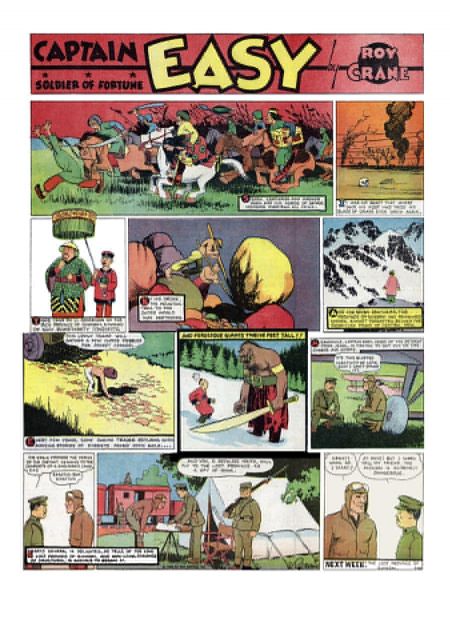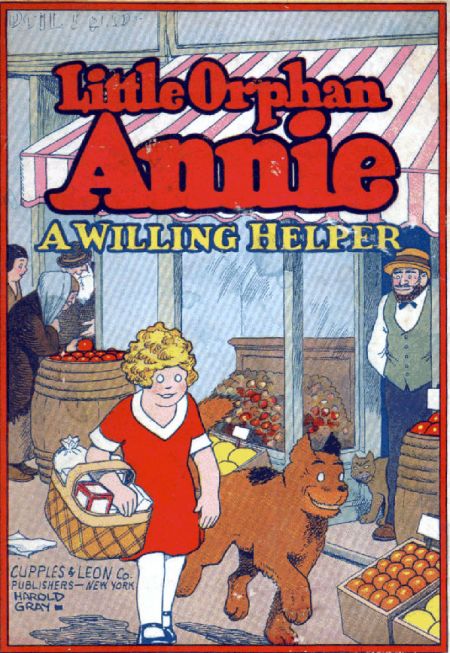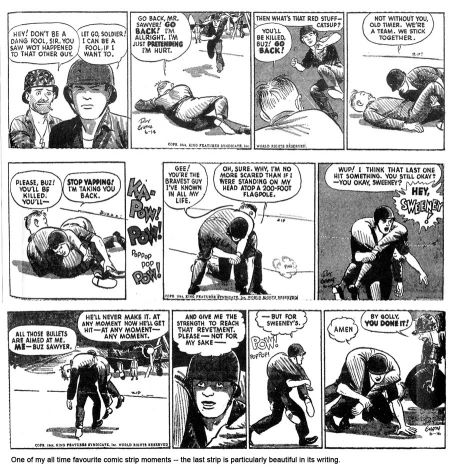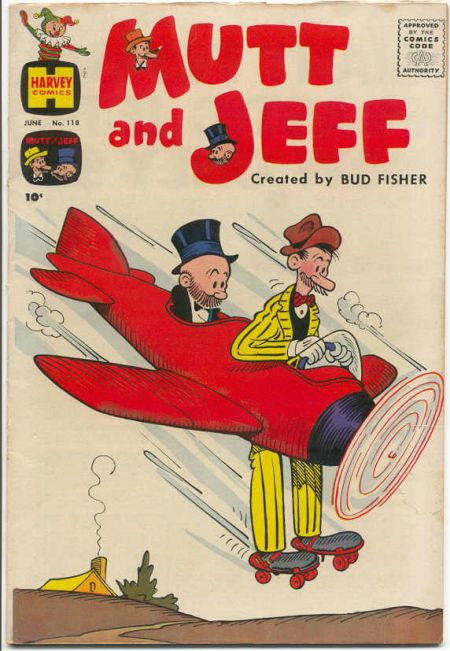Comics /
Comic Reviews /
Comic Strips
How To Read Classic Newspaper Strips And Why You Should
By Tom Spurgeon
October 26, 2008 - 20:30
The Golden Age of Comics in which we find ourselves today may be so big, so grand, so stuffed with new books of every stripe that entire categories are in danger of getting passed over in discussions of what's out there and what's important. Lost in the explosion of translated manga as a bookstore phenomenon, the surge of interest in superhero-related films and their graphic novel forebears, the emergence of popular on-line comics and the rise of the literary graphic novel lies the second great age of newspaper strip reprints. It is an amazing time to be a fan of older comic strips. Following the success of the Complete Peanuts series at Fantagraphics and the massive sales for
Far Side and
Calvin and Hobbes slip-cased editions from Andrews McMeel have come a flood of classic and new classic titles in ready-for-your-bookshelf format. Among the titles out there fighting for display space and catalog inches with
Watchmen and
Fruits Basket and
Achewood are such tried and true giants of the form as
Thimble Theatre,
Mutt and Jeff,
Little Orphan Annie,
Scorchy Smith,
Dick Tracy,
Terry and the Pirates,
Gasoline Alley,
Krazy Kat, and
Little Nemo In Slumberland. Throw in works like
The Little King and
Barney Google from on-line sources, as well as aggressive, multiple-format programs for tomorrow's classics like
Mutts and
Pearls Before Swine and a fan of comic strips could spend as much in monthly outlays as any superhero fan or graphic novel devotee.
 |
The rise of the Direct Market and the success of modern collections like the
Doonesbury and
Garfield series sparked a similar boom in older newspaper comics that lasted from the 1980s through the early 1990s. The major differences between then and now is that 1) many of today's collections mean these strips are seeing a second or even a third life in bookstore ready-formats, and 2) the shelves are much more crowded. Adults looking for an entertaining comics read 15-20 years ago may have simply rolled the dice on a
Dickie Dare or
Alley Oop collection after picking up some of the dismal graphic novels limping onto bookshelves in the wake of
Maus. If a consumer picked up a
Prince Valiant book in 1988, they were buying work that hadn't been seen except by hardcore collectors and maybe European audiences since the day it came out. That has certainly changed. What comic strip reprint projects must do in today's market is move past nostalgia buys and impulse purchases to entertain and provide enjoyment on the same level as any other words and pictures effort out there. There are not yet enough comics readers in North America that one can count on a significant minority having a curatorial interest in keeping older work alive, and there are too many great graphic novels and comic books and on-line works for reprints to be able to count on a trickle down effect. A comic strip reprint rolling off the presses in 2008 has to dance for its supper. Nothing is guaranteed.
Luckily, many of these great works know a thing or two about pleasing an audience. The best comic strips from the 20th Century entertained millions of people. They stood on the front lines of visual media as consumed by the average American. If you wanted to see something amazing in the 1920s, if you wanted to step into another world, you couldn't go to your computer or your TV. The movies and their crude effects might disappoint. Open up the Sunday funnies, though, and you saw page after page of vibrant colors and remarkable stories and beautifully crafted art work accessible to everyone in an average household. Still, there are a few very real differences between reading George Herriman and George McManus and plunging into Grant Morrison and Marjane Satrapi. Here are a few tips for taking a comics trip into the past in a way that can help yield the most satisfying results.
 |
Think Stage, Not Screen: Comic strips and movies developed around the same time and enjoyed a back-and-forth relationship in their infancy. Creators like Winsor McCay innovated in both media. For the most part, however, unlike the first comic book makers, the first generation of comic strip artists was more likely to see entertainment on stage than on screen. Therefore, a lot of the basic form of the comic strip resembles drama and comedy presented to you through a static window rather than something that you followed through swooping camera angles and Hollywood jump cuts. It's only in the adventure strips in the 1930s on that you get a filmic sensibility that makes an impact, most memorably in war stories from artists like Roy Crane,
Milton Caniff and Noel Sickles. That's not to mean that strips like
Little Orphan Annie or
Mutt and Jeff never took their action outside or features like
The Gumps or
Bringing Up Father didn't vary their locations. It's more that they framed each scene like something happening right in front of than a sequence from a movie, the same way there's a difference between early television shows like The Honeymooners and a modern TV program utilizing handheld cameras like The Office. Seeing the older strips as a entertaining stage show with outsized characters come to entertain you can provide you with another level of appreciation for the basic, pleasing, showmanship of the older strips, and may even give you a clue as to how startling something more film-like such as
Terry and the Pirates was to audiences when it began to take off.
Enjoy The View: We often bemoan the modern comic strip for their lack of size. The dependency on simplified or even crude drawing that can communicate in a tiny space might disappoint those of us used to bigger comics. That was hardly the case 50, 75, 100 years ago. Take pleasure in the good-looking art provided in nearly every major collection. Milton Caniff's dramatic inking style on display in
Terry and the Pirates, Walt Kelly's Disney-quality, funny-animal cartooning in
Pogo, Harold Foster's stunning
Prince Valiant art, and Winsor McCay's jaw-dropping illustration in
Little Nemo provide obvious joys. They're beautiful! It's amazing that cartoonists of that day were turning out illustrative work of that quality on a weekly or sometimes even daily basis. Some of the best drawing isn't even obviously impressive. Take something as initially unassuming as
Little Orphan Annie. With little more than judicious use of white space and an attention to architectural detail, Harold Gary created a world with character of its own, a universe where his red-haired moppet struggled to find home and safety as the sky itself pressed down upon her and the buildings loomed over her and Sandy's heads. Frank King's
Gasoline Alley Sundays are justifiably famous for the playfulness of their design. One might be comprised of a single image broken down into panels, while another might feature amazing colors and expressive drawing as was the case in a series of yearly strips where lead characters Walt and Skeezix wander out into the Fall countryside. Nothing in any art form looks like Krazy Kat, and the drawings in Thimble Theatre are so pungent and well designed and funny that you can practically feel the seaside breeze. We stress narrative so strongly in today's comics. Older comic strips feature story in spades, but they also found time for first-rate art, and there's nothing wrong with taking them in on that level.
The Daily Dose: Today we read comic strips on-line and in collected form nearly as frequently as we see them through our daily newspaper. When many of the classic strips were created, they were read in the newspaper and then forgotten -- unless you were cutting them out yourself and keeping them in a drawer! With only so much time to build an impression, early strips are very good at making their point. They don't get to have down days, nor are they allowed to repeat a lot of jokes, nor do we see them build over several days to a specifically funny single moment. In fact, in some of the Sundays, older comic strips would stuff their space with additional features in the margins of the original. That's how
Krazy Kat began, and for many fans a
Thimble Theatre Sunday strip isn't complete without getting to read the "
Sappo" feature that E.C. Segar plopped on top of
Popeye's adventures. Another noticeable way the transient nature of old strips has an effect is that strips with continuing stories like
Little Orphan Annie or
Wash Tubbs or
Prince Valiant mastered soap opera. People in that generation paid as much attention to the plots of certain strips as audiences do today to the juiciest prime-time television shows. When a prominent character named Raven Sherman died in a 1941
Terry and the Pirates, adults and kids all over the country shook their heads disbelief over what happened. It's fun to read the strips and get behind the creator's attempt to weave a spell over his audience in the 30 seconds he has their attention. You may find that you not only enjoy certain strips, you start to root for them.
Remember That There Was No Underground: The writer Dan Nadel offered up an interesting theory in his 2007 book
Art Out Of Time. Nadel believes that because comics didn't have an underground until the 1960s, a natural avenue for personal expression above and beyond commercial considerations, a lot of work that might have been done there had to find expression in comics to be read by the entire family in hundreds of thousands of households. In other words, if someone in 2008 wants to make comics about their family relationships, they can make a graphic novel that addresses this subject directly: Fun Home. But if you wanted to talk about your family's problems in 1928, you needed to find a way to do it that entertains millions: The Bungle Family. Seeking out the personal touch can alter our readings of a lot of the great newspaper strips. It's certainly possible that vigorous globe-trotting enjoyed by Captain Easy and Washington Tubbs in Roy Crane's comics may have been informed by the cartoonist's younger days traveling the world as much as it was by a certain conception of America in the full bloom of its youth. Reading
Gasoline Alley today, it's hard not to see the life of Walt Wallet as a kind of fantasy bachelorhood carefully constructed by Frank King. With that in mind, the arrival of the orphaned Skeezix becomes a deeply affecting portrayal of how parenthood can change everything about our lives. A more quotidian example of a personal touch can be found in
Krazy Kat's wild background and landscapes, drawn not just for their visual splendor but from cartoonist George Herriman's deep adoration for the American southwest. Keeping in mind the consuming nature of daily strip production and how close these works were to their creators' lives and how they had nowhere else to go provides an opportunity to see many of the greatest comics of all time in a brand-new light.
Dive In, Already!: The great, baroque designs of
Little Nemo in Slumberland or the strange language slipping out of
Popeye's mouth in
Thimble Theatre can be a daunting hurdle for many modern readers. Believe me,
Krazy Kat's odd look and garbled speechmaking can intimidate the most fanatical comics reader. Our first reaction may be to see these features as something obtuse and difficult, some sort of mountain to be climbed, some sort of object far removed from out experiences. Nothing could be further from the truth. All of the strips popular enough to reprint today had during their initial publication millions of fans from all walks of life. They were at least as accessible as anything you might watch on network TV today. Modern comic books and graphic novels and even today's newspaper strips can be great and fun and many are wonderfully executed, but comic books from decades past were not only great, they were everywhere. So forget about scaling the heights: just start reading; you'll figure it out. Don't get caught up on
Krazy Kat as a ornate love triangle of unrealized expectations with strange, flowery language and metaphorical landscapes; jump on board and read a few and just like anything funny and popular and worthwhile today the rhythms will become apparent to you the more you get into it. You'll likely discover that despite
Krazy Kat's formidable reputation, it could be a very silly strip, with a lot of humor on all levels, including physical comedy that would shame The Three Stooges. Its pictures aren't abstract; they're pretty, and the colors not strange but comforting and warm. All of the great comics of yesterday are like the greatest comics of today in that they will teach you how to enjoy them if you'll only take the first step.
I implore every comics fan out there to stop seeing comics from the vantage point of different groups sitting around individual fires and start seeing them as fellow travelers in a sprawling camp with fires that light up the entire valley. Invite one of these old guys home. Four of the great North American comic book and graphic novel publishers have significant reprint arms. Fantagraphics currently publishes
The Complete Peanuts and
Krazy Kat; they will soon add
Wash Tubbs/Captain Easy,
Prince Valiant and
Pogo. IDW is making to die for volumes out of such newspaper titans as
Dick Tracy,
Little Orphan Annie,
Scorchy Smith and
Terry and the Pirates. The Montreal publishing house Drawn and Quarterly is giving us the sweetly sentimental
Gasoline Alley dailies and Tove Jansson's forgotten and gem-like
Moomin. NBM is releasing a series of older strips in collected form, starting with this year's
Mutt and Jeff. Add Classic Comics Press and their work with great, maybe slightly less well-known strips like On Stage, toss in the obscure old strips on syndicate web sites like DailyInk.com and on private sites like BarnaclePress.com, and nod in the direction of the publisher Sunday Press Books and their beautiful, oversized
Little Nemo and
Gasoline Alley Sundays. That's quite a line-up.
It's clear that a whole world of cartooning as well as the vital history of the art form in living color is out there for you to grab. If you read today's comic books, or devour manga or follow strips on-line, you may enjoy the older work the way a re-run of a classic TV show is a great supplement to the current primetime offerings. If you're a fan of graphic novels, you'll see art in and approaches belonging to and a scope to classic newspaper strips you'll recognize in many of your favorite books. Most of all, for everyone out there, these are simply great comics, and your life will be richer if you find one that speaks to you.
Last Updated: January 17, 2025 - 08:20



